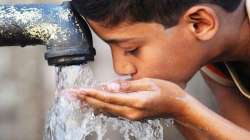Delhi Jal Board claims water supplied by it fit to drink straight from tap, RO purifiers not needed
When government utilities like the DJB,are supplying water after cleaning it, there's no need for people to install ROs, an official of the Delhi Jal Board said.

After the National Green Tribunal (NGT) Tuesday directed the government to prohibit the use of RO purifiers, the Delhi Jal Board on Thursday claimed water supplied by it does not need to be treated by reverse osmosis purifiers and is "fit enough" to drink straight from the tap. The tribunal had barred the use of water purifiers where total dissolved solids (TDS) in water were below 500 mg per litre.
TDS is made up of inorganic salts and small amounts of organic matter.
A WHO study has revealed the TDS levels below 300 mg per litre are considered to be excellent, while 900 mg per litre is said to be poor and above 1,200 mg is unacceptable.
Reverse Osmosis (RO) is a treatment process that removes contaminants from water by using pressure to force molecules through a semipermeable membrane.
Shalabh Kumar, Member (Water), DJB said, "RO purifiers are not required for water supplied by the DJB. It is fit enough to drink. We follow the guidelines set by the WHO and keep the TDS content between 100 and 200 mg per litre and pH value between 7 and 7.8 within permissible limits."
"The TDS content in the RO water is less than 100 mg per litre and the minerals get removed. Water supplied by the DJB contains minerals and is drinkable. It is not at all harmful for the body," he said.
Pesticide and chemical content in the raw water, sourced primarily from the Yamuna, is generally within limits. The DJB follows coagulation and disinfection processes to remove any such harmful content. Water samples are checked every hour, Kumar said.
The NGT had also expressed concern over unnecessary wastage of potable water on account of use of RO systems.
The Water Quality Indian Association, representing RO manufacturers, had told the green tribunal that RO purifiers ensures availability of pure water. It is, however, not disputed that only 20 per cent water is recovered and 80 per cent goes waste.
Environment activist Manoj Mishra said water with TDS content below 500 mg per litre is clean and fit to drink.
"RO technology creates dead water, which is bereft of necessary minerals and salts. It is not good at all for human consumption. RO purifiers can be used at places where the water table has dropped alarmingly and the water is salty... when you do not have any other option," he said.
"This technology has been promoted by market forces by creating a fear psychosis, and not because people really need it. They have come up with the heavily-loaded word 'pure' and people fall for it," he said.
Also Read | Evidence of water found on Ultima Thule, the farthest place visited by mankind
"We are making children, the elderly and those who are ill drink dead water without realising what we are doing. People are inviting serious medical problems by drinking dead water that comes out of RO purifiers. For example, if the water does not have required sodium content, it can lead to mental imbalance," Mishra claimed.
When government utilities, like the DJB, are supplying water after cleaning it, there's no need for people to install ROs, he said.
The technology should not be allowed to use across the board. It should be used selectively, only where tests have confirmed that there is actually a serious problem with the water, the activist said.
Kent RO systems chairman Mahesh Gupta said people would not require RO purifiers if the tap water is drinkable and there are several reports that say otherwise. A similar report was tabled in Parliament in 2015, he said.
"There are a lot of issues even if water has less than recommended TDS. It could contain elements beyond the prescribed limit. In those cases, people can get serious diseases even if TDS is within 500 mg per litre limit," he said.
"There is the issue of arsenic, fluoride and heavy metals including pesticides in most parts of the country. Further, microplastics in river water is a big issue," he added.
"According to a recent report published in one of the renowned English dailies, the amount of antibiotics found in Indian water bodies is more than the permissible limit. Then, how do we expect a normal consumer to make an assessment about the quality of water? RO Water purifiers are best equipped for this," Gupta claimed.
ROs follow a process wherein essential minerals are maintained and a minimum of 50 TDS of water is given to all consumers which tastes the best and meets the requirements of minerals, he said.
In fact, there is no limit of minimum mineral content in drinking water by Indian standards as well as the World Health Organization, he added.